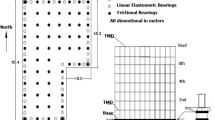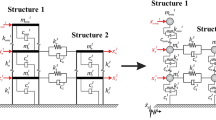Abstract
The concept of coupled building is utilized to synchronize the response of two adjacent buildings and reduce the minimum gap needed. This aims to avoid the pounding hazard between the two buildings, which are coupled together. With this background in view, two ten-storey-high planar buildings with different dynamic proprieties are connected with the help of a magneto-rheological (MR) damper. The MR damper is located at the top floor of the buildings. The semi-actively controlled MR damper is driven by a passive-on, passive-off, on-off controller and fuzzy logic controller. A comparative study is conducted for adjacent planar buildings, with testing of different control strategies. It is shown that a coupling strategy allows transforming the two separated structures into one system coupled by a damping device, which results in a synchronized vibrating mode between the two coupled structures. It has been found that the chances of pounding are reduced along with a reduction in terms of displacement, acceleration and inter-storey drift. The use of a fuzzy logic controller results in an optimization in terms of damper force. In addition to this, it is also observed that the use of a single damper at the top floor has a significant effect on the reduction of pounding between the two buildings.













Similar content being viewed by others
References
Bertero VV (1987) Observations on structural pounding. In: The Mexico earthquakes—1985 factors involved and lessons learned, ASCE, pp 264–278
Anagnostopoulos SA (1988) Pounding of buildings in series during earthquakes. Earthq Eng Struct Dyn 16(3):443–456
Kasai K, Jeng V, Patel P, Munshi J, Maison B (1992) Seismic pounding effects-survey and analysis. In: Proceedings of the 10th world conference on earthquake Engineering, pp 19–24
Comartin CD, Greene M, Tubbesing SK (1995) The Hyogo-Ken Nanbu Earthquake preliminary reconnaissance report. Earthquake Engineering Research Institute, Oakland, CA
Cole GL, Dhakal RP, Turner FM (2012) Building pounding damage observed in the 2011 Christchurch earthquake. Earthq Eng Struct Dyn 41(5):893–913
Naserkhaki S, Aziz FNA, Pourmohammad H (2012) Earthquake induced pounding between adjacent buildings considering soil–structure interaction. Earthq Eng Eng Vib 11(3):343–358
Zhai C, Jiang S, Li S, Xie L (2015) Dimensional analysis of earthquake-induced pounding between adjacent inelastic MDOF buildings. Earthq Eng Eng Vib 14(2):295–313
Jeng V, Tzeng W (2000) Assessment of seismic pounding hazard for Taipei City. Eng Struct 22(5):459–471
Dogan M, Gunaydin A (2009) Pounding of adjacent RC buildings during seismic loads. J Eng Archit Fac Eskişehir Osmangazi Univ 22(1):130–145
Kobori T, Yamada T, Takenaka Y, Maeda Y, Nishimura I (1988) Effect of dynamic tuned connector on reduction of seismic response-application to adjacent office buildings. In: Proceedings of the 9th world conference on earthquake engineering, pp 773–778
Westermo BD (1989) The dynamics of interstructural connection to prevent pounding. Earthq Eng Struct Dyn 18(5):687–699
Seto K (1994) Vibration control method for flexible structures arranged in parallel. In: Proceedings of the first world conference on structural control
Zhang W, Xu Y (1999) Dynamic characteristics and seismic response of adjacent buildings linked by discrete dampers. Earthq Eng Struct Dyn 28(10):1163–1185
Zhu H, Xu Y (2005) Optimum parameters of Maxwell model-defined dampers used to link adjacent structures. J Sound Vib 279(1):253–274
Christenson RE, Spencer B Jr, Johnson EA, Seto K (2006) Coupled building control considering the effects of building/connector configuration. J Struct Eng 132(6):853–863
Bharti S, Dumne S, Shrimali M (2014) Earthquake response of asymmetric building with MR damper. Earthq Eng Eng Vib 13(2):305–316
Qu W, Xu Y (2001) Semi-active control of seismic response of tall buildings with podium structure using ER/MR dampers. The struct des tall build 10(3):179–192
Xu Y, Chen J, Ng C, Qu W (2005) Semiactive seismic response control of buildings with podium structure. J Struct Eng 131(6):890–899
Bharti S, Dumne S, Shrimali M (2010) Seismic response analysis of adjacent buildings connected with MR dampers. Eng Struct 32(8):2122–2133
Motra GB, Mallik W, Chandiramani NK (2011) Semi-active vibration control of connected buildings using magnetorheological dampers. J Intell Mater Syst Struct 22(16):1811–1827
Shahidzade M, Tarzi H, Dorfeshan M (2011) Takagi-Sugeno fuzzy control of adjacent structures using MR dampers. J Appl Sci 11:2816–2822
Shrimali M, Bharti S, Dumne S (2015) Seismic response analysis of coupled building involving MR damper and elastomeric base isolation. Ain Shams Eng J 6(2):457–470
Spencer BF, Dyke SJ, Sain MK, Carlson JD (1997) Phenomenological model for magnetorheological dampers. J Eng Mech 123(3):230–238
Zadeh LA (1965) Fuzzy sets. Inf Control 8(3):338–353
Mamdani EH, Assilian S (1975) An experiment in linguistic synthesis with a fuzzy logic controller. Int J Man Mach Stud 7(1):1–13
Battaini M, Casciati F, Faravelli L (1998) Fuzzy control of structural vibration. An active mass system driven by a fuzzy controller. Earthq Eng Struct Dyn 27(11):1267–1276
Choi KM, Cho SW, Jung HJ, Lee IW (2004) Semi-active fuzzy control for seismic response reduction using magnetorheological dampers. Earthq Eng Struct Dyn 33(6):723–736
Pătraşcu M, Dumitrache I, Pătruţ P (2012) A comparative study for advanced seismic vibration control algorithms. UPB Sci Bull Ser C 74(4):3–16
Wu X, Griffin M (1997) A semi-active control policy to reduce the occurrence and severity of end-stop impacts in a suspension seat with an electrorheological fluid damper. J Sound Vib 203(5):781–793
Author information
Authors and Affiliations
Corresponding author
Rights and permissions
About this article
Cite this article
Abdeddaim, M., Ounis, A., Djedoui, N. et al. Pounding hazard mitigation between adjacent planar buildings using coupling strategy. J Civil Struct Health Monit 6, 603–617 (2016). https://doi.org/10.1007/s13349-016-0177-4
Received:
Revised:
Accepted:
Published:
Issue Date:
DOI: https://doi.org/10.1007/s13349-016-0177-4




